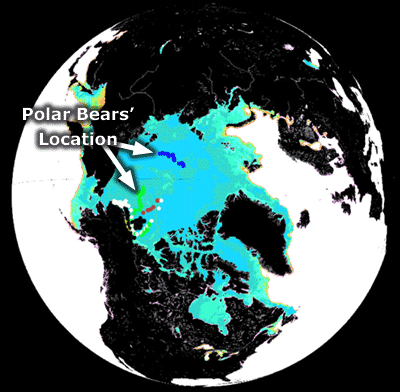 | In this Section: | |  | In the Spotlight |  | News |  |
List of "In the Spotlight" Features
Long Term Studies of Polar Bears Search for Answers

|
Polar bears are a very interesting species to students and scientists alike! You may have seen on TV, the web, or in newspapers that Global Climate Change threatens to have a huge effect on this charismatic species.
Scientists like ACES partner Dr. Geoffrey York of the United States Geological Survey (USGS) Alaska Science center have been tracking polar bears by satellite to learn more about where they go and how they use different habitats.
Biologists are concerned that as the sea ice in the Arctic decreases, these animals will definitely be affected. Polar bears use sea ice as a platform from which to hunt their favorite prey, seals. They hunt seals by waiting for them to surface through holes in the ice or by capturing seals when they haul-out on the ice. Polar bears also hunt seals by attacking their lairs. Seals build lairs on the ice to protect their pups. As the climate warms the seal lairs are melting earlier in the spring. This reduces the number of seal pups that survive and further limits the polar bears' food supply.
Some people in the Arctic Circle are noticing that polar bears seem to be using land habitats more frequently. Unfortunately, Alaska shorelines, for example, are fairly unproductive. There just isn't enough food on land to support these giant animals. Adult males can reach 3 meters (about 10 feet) tall and weigh over 450 kilograms (about 1,000 pounds)! They need the fatty, calorie-dense seals to support their large size. If sea ice continues to disappear, it is likely that many polar bears will not survive.
Scientists have been studying polar bear populations since the 1960's, collecting data including the animals' heights, weights, and how many cubs and adults survive. They are also looking at long term issues related to polar bear health, including how the animals may be affected by diseases and pollutants. Long term studies like these are extremely important, particularly when scientists are studying large scale changes such as climate changes and how species might react to them. Ongoing studies are the only way that scientists can draw true conclusions about these types of issues.
Dr. York explains that, for students and citizens, it is important to consider how our everyday activities add greenhouse gases to the atmosphere that contribute to climate change. Learn about how you can reduce your own 'carbon footprint' so that, as a planet, humans can start to address this global issue. Dr. York says, "Let's get ahold of that sooner rather than later, because the sooner we collectively take action, the sooner we might see that turn around, and that's good news for polar bears."

The map above shows dots representing the location of a few Polar Bears currently in the Arctic on top of Sea Ice Concentration Data. The view is from the top of the Earth looking down at the North Pole. |
|
